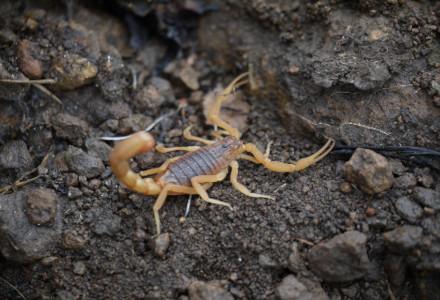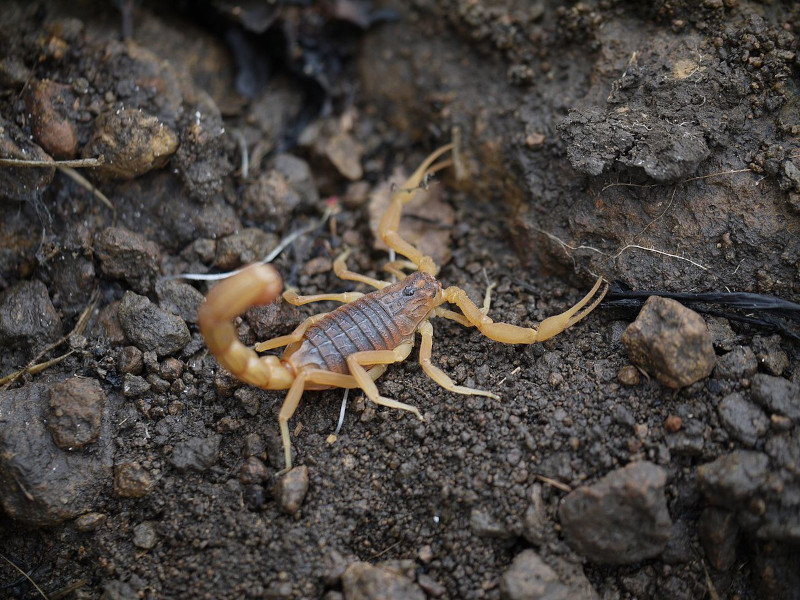Indian Red Scorpion
- This amazing variety of arthropod most frequently goes by the dually descriptive and informative common name of the Indian Red Scorpion. Like the great majority of species in the world, though, this invertebrate also possesses other common names.
- Due to this, it also goes by the term of the eastern indian scoprion. The scientific name for it, however, merits some attention, and even a little humor. That’s because, unlike the typical, hard to pronounce technical term, it’s named the Hottentotta tamulus.
- The creature received that intriguing formal name, furthermore, at the hands of the renowned Danish zoologist Johan Christian Fabricius. He made the first recorded ackowledgement of the animal as a separate and distinct species in the year 1798.
- For the moment, it’s not yet been evaluated by the IUCN for placement on its Red List. Presently, however, its population apears to remain reasonably abundant. This further seems to hold true throughout the entirety of its known zone of habitation.
- Much like all living things around the globe, though, it nevertheless faces potential dangers to its continued existence as a species. Its current fortunate situation, therefore, could potentially change, and for the worse, in the foreseeable future.
- That’s true because the nature of its habitat and the location of its range renders the Indian Red Scorpion vulnerable to habitat loss. Like other species around the world, it’s also currently threatened by the ever-increasing effects of ongoing climate change.
Related Articles
Indian Red Scorpion Physical Description
The aptly-named Indian Red Scorpion certainly merits attention and respect. The arachnid does not, however, do so due to sheer size. That’s because, regardless of its other qualifications, it in fact ranks as smaller than average in terms of that particular statistic.
It also displays a very slight degree of the physiological characteristic of sexual dimorphism. Unlike many species, though, this trait does not manifest itself in terms of physical size. Due to this fact, both genders of the species remain hard to distinguish visually.
Individuals of both genders further vary significantly in terms of overall length. Somewhat surprisingly, this ranges from 2 – 3.5 in (5.1 – 8.9 cm). This large variation in body length among mature individuals occurs primarily due to various environmental factors.
The general coloring of this remarkable arthropod also displays a wide range. The creature manifests colors that, in fact, range from a dull brown to a bright reddish orange. Most individuals also display farily prominent ridges, colored a relatively dark gray.
The Indian Red Scorpion displays its gender-based difference in terms of its pedipalps. Like many spiders, these appendages, among the males of this arachnid, develop slightly larger than their female counterparts. It also appears flourescent under black light.
- Kingdom: Animalia
- Phylum: Arthropoda
- Class: Arachnida
- Order: Scorpiones
- Family: Buthidae
- Genus: Hottentotta
- Species: H. tamalus
Indian Red Scorpion Distribution, Habitat, and Ecology
Fortunately for it, the amazing Indian Red Scorpion evolved as native to a moderately large swathe of the world. That zone of habitation, furthermore, covers a portion of what men now call Asia. As its name hints at, the arthropod appears in most of the country of India.
Yet the intrepid invertebrate also appears in portions of several other countries in the region. Historically, these included the eastern sections of both Pakistan and Nepal. The resourceful arachnid has, however, apparently spread to the country of Sri Lanka in recent times.
Remarkably, detailed knowledge of certain aspects of its ecology remains scarce. This marvel of Nature and evolution does, however, appear to prefer to make its home in regions of fairly high humidity. This further includes areas of both tropical and subtropical climate.
For reasons yet to be fully determined, the arachnid also displays a strong tendency to live near or even in regions of human habitation. This most unexpected, and also unusual, behavioral pattern holds especially true in the more rural areas of its habitat range.
Wherever individuals of this fascinating species appear, though, these maintains certain other patterns of behavior. Like the rest of its relatives, it evolved as both a carnivore, and an ambush predator. The intriguing inertebrate further mainly hunts nocturnally.
The principal prey for this highly evolved predator typically consists of various small invertebrates, such as cockroaches. It nevertheless does occasionally consume small vertebrates, as well. This sometimes includes prey as large as small rodents and lizards.
Though sometimes kept as pets, the Indian Red Scorpion possesses a highly toxic venom. Stings most commonly occur, however, if the creature is stepped on or handled. Though, uncommon, fatalities do happen following stings, most often among young victims.
Species Sharing Its Range
Check out our other articles on 3 Bewildering New Guinea Birds, Reef Manta Ray, New River, Southern Tamandua, Malaysian Dead Leaf Mantis, Anegada ground iguana


